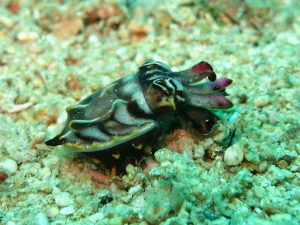Sea stars, also known as starfish, are widespread marine invertebrates which live on the bottom of the oceans from the tropics to the polar areas. There are over 1,800 species of sea stars, most occurring in shallow waters, but some occurring to abyssal depths of almost 20,000 feet. They range in size from ½ inch to over three feet in diameter and come in a variety of colors and patterns. Being closely related to brittle stars, sea urchins, sand dollars, and sea cucumbers, sea stars are in the phylum Echinodermata. Like all Echinoderms, sea stars have five-point radial symmetry, which means that their body plan has five sections arranged around a central disk. Most common species have 5 arms but some species can have 10, 20, or even up to 50 arms.
Sea stars have a hard endoskeleton located under their skin. Their tough skin is covered with small spines which help protect them from predators such as birds, fish and sea otters. The underside of sea stars is soft and vulnerable, consisting of a mouth in the center with a groove radiating out each leg that is covered in hundreds of tiny, flexible appendages called tube feet. Movement of the starfish is accomplished with the tube feet, which also have suction cups on the ends, which allow them to grip things strongly. At the end of each arm is a short sensory tentacle which is sensitive to chemicals and vibrations in the water, and a red photosensitive eyespot which senses light and movement. If a sea star loses an arm it will regenerate a new one. In many species, the lost arm will grow into a new sea star, especially if the lost arm retains part of the central disk. Sea stars lack blood but instead use a hydraulic-like water vascular system which is unique to Echinoderms.
Sea stars are carnivores, feeding mostly on bivalves, such as clams, mussels, and oysters, which they open with their strong arms and tube feet, but will eat just about anything that is too slow to move out of the way. One species, the crown of thorns sea star, feeds on coral polyps. Sea stars have the ability to digest their prey outside of their bodies which enables them to feed on prey that is too large for them to fit in their mouths. They accomplish this by using one of their two stomachs which is extended outside the body through the mouth, coming in contact with the captured prey, and digesting it.
Not only has God placed stars in the seas and in the heavens, but He has placed them in crowns for us which He is waiting to give us soon if we are faithful. “God is well pleased if those striving for eternal life aim high. There will be strong temptations to indulge the natural traits of character by becoming worldly wise, scheming, and selfishly ambitious, gathering wealth to the neglect of the salvation which is of so much higher value. But every temptation resisted is a priceless victory gained in subduing self; it bends the powers to the service of Jesus, and increases faith, hope, patience, and forbearance. … Let us aim in the strength of Jesus for the crown heavy with stars. ‘They that be wise shall shine as … the firmament; and they that turn many to righteousness as the stars for ever and ever’ (Daniel 12:3).” That I May Know Him, 91. “Behold, I come quickly: hold that fast which thou hast, that no man take thy crown.” Revelation 3:11.
David Arbour writes from his home in De Queen, Arkansas. He may be contacted by e-mail at: landmarks@stepstolife.org .
